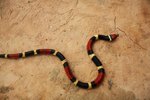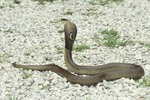
Of the 33 species of snakes in Northern California, only six are venomous to humans, and all six are varieties of rattlesnake. While it's natural for people to be frightened of snakes, knowing and being able to identify the most common and harmless species of snakes in the area is helpful in understanding how to deal with them.
Gopher Snake

The most common snake in northern California -- and one often mistaken for a rattlesnake -- is the Pacific gopher snake. Gopher snakes range in color from gray to dark brown and sport alternating black and brown spots along the length of their bodies. This snake is diurnal, meaning it hunts during the day and sleeps at night. When threatened, the snake will flatten its body and shake its tail. While it has no rattle, a rattling sound can be heard in dry grasses, leading observers to believe it to be a rattlesnake. The gopher snake is nonvenomous and not harmful to humans.
Coachwhips

Another common northern California snake is the coachwhip. Long and thin, with large eyes, the coachwhip comes in a variety of colors and patterns. Most coachwhips have some red coloring on their bodies. This snake as a species is very fast and will flee rather than fight when discovered. The coachwhip is a curious snake, and has been known to lift its head above grasses or shrubs to peer around the landscape. While the bite of the coachwhip is painful, it's harmless, and the snake will only bite if improperly handled.
Sharp-tailed Snake

Although the sharply pointed barb at the end of the sharp-tailed snake's tail looks deadly, it's actually merely a protruding remnant of the snake's tail vertebra and is not toxic and cannot hurt humans. Instead, the spiny point is used to hold slugs and small prey for the sharp-tailed snake to eat. The top of the sharp-tailed snake ranges in colors to suit its surroundings -- from forest brown to desert clay red -- and the underbelly is striped in black and white. This snake is very shy and may play dead when discovered hiding under a rock or rotting wood.
California Kingsnake

A popular pet for reptile owners, the California kingsnake can also be found endemically throughout northern California. Although they are nonvenomous, the kingsnake is so called for its ability to dominate other snakes as food, including venomous rattlesnakes. When disturbed, the California kingsnake will mimic the rattlesnake's curl and tail rattle as a form of defense. Due to selective breeding, the kingsnake can be found in a wide range of colors; typically in the wild, the colors of the kingsnake are bands of brown and white, black and white or black and yellow.
Rattlesnake

Of all the rattlesnake types, only the Pacific rattlesnake is found in northern California. Pacific rattlesnakes can reach a length of 5.5 feet, and the skin color ranges from dark gray to nearly black, with hexogonal markings. When surprised, the rattlesnake will coil, rear its head back and rattle fiercely; be wary as it may strike at any time. Fortunately, the Pacific rattlesnake is usually active only in the spring and summer months and will hibernate from November to February. In the springtime, mornings and late afternoons are the times to be aware of potential rattlers, as this is when they hunt. When the weather turns hotter, the snake becomes nocturnal and is rarely seen during the day.
References
- United States Geological Survey Southwest Biological Science Center: Facts About Snakes in California
- Kingsnake: Pacific Gopher Snake (Pituophis catenifer catenifer)
- University of Georgia Herpetology Program: Coachwhip
- Florida Museum of Natural History: Coachwhip Snake
- University of Michigan Museum of Zoology: Sharp-tailed Snake
- California Herps: California Kingsnake
- California Department of Fish and Wildlife: Rattlesnakes in California
- California Poison Action Line: Northern Pacific Rattlesnake
Resources
Photo Credits
-
Jupiterimages/Photos.com/Getty Images




